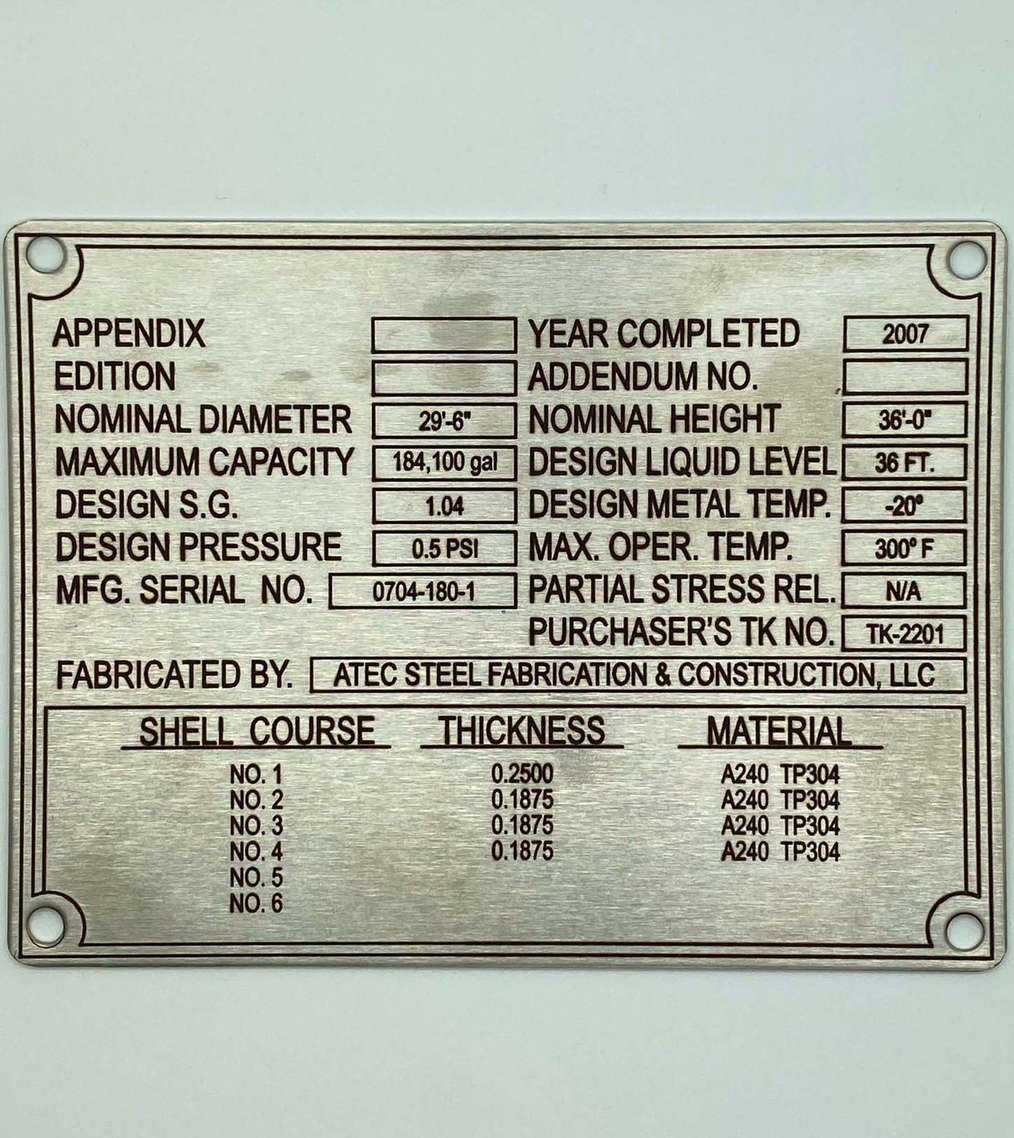16VAC25-50-380. Pressure vessels.
A. Maximum allowable working pressure for standard pressure vessels. The maximum allowable working pressure for standard pressure vessels shall be determined in accordance with the applicable provisions of the edition of the ASME Code or API-ASME code under which they were constructed and stamped. The maximum allowable working pressure shall not be increased to a greater pressure than shown on the manufacturers nameplate stamping and data report.

This means that if a manufacturer is accredited by the ASME organization for pressure vessels per ASME Code Section VIII Div. 1, they can stamp the letter “U” in the pressure vessel nameplate. See the following Fig. For Pressure Vessel Certification (The Stamp Item).
The document, along with the nameplate, is proof to all federal, state, and local regulators that your pressure vessel meets the requirements of the ASME Code. Without the data report and the. The first edition of the Boiler and Pressure Vessel Code, known as the 1914 edition, was a single 114-page volume. It developed over time into the ASME Boiler and Pressure Vessel code, which today has over 92,000 copies in use, in over 100 countries around the world. Canada has a B51 standard that provides a more inclusive definition of what a pressure vessel is. Canada has a FITTINGS category for items that that are not vessels but need to be built under a quality control program. Pressure Vessels.
B. Maximum allowable working pressure for nonstandard pressure vessels.
Pressure Vessel Plate Steel

1. For internal pressure. The maximum allowable working pressure on the shell of a nonstandard pressure vessel shall be determined by the strength of the weakest course computed from the thickness of the plate, the tensile strength of the plate, the efficiency of the longitudinal joint, the inside diameter of the weakest course and the factor set by this chapter.
TStE | = | maximum allowable working pressure, psi |
RFS |
where:
TS = ultimate tensile strength of shell plate, psi. When the tensile strength of the steel plate is not known, it shall be taken as 55,000 psi for temperatures not exceeding 700°F.
t = minimum thickness of shell plate of weakest course, inches.
E = efficiency of longitudinal joint depending upon construction. Use the following values:
For riveted joints -- calculated riveted efficiency; and
For fusion-welded joints:
Single lap weld | 40% |
Double lap weld | 50% |
Single butt weld | 60% |
Double butt weld | 70% |
Forge weld | 70% |
Brazed steel | 80% |
R = inside radius of weakest course of shell, inches, provided the thickness does not exceed 10% of the radius. If the thickness is over 10% of the radius, the outer radius shall be used.
FS = factor of safety allowed by this chapter.

2. For external pressure. The maximum allowable working pressure for cylindrical nonstandard pressure vessels subjected to external or collapsing pressure shall be determined by the rules in the ASME Code, Section VIII, Division 1.
3. Factors of safety. The minimum factor of safety shall in no case be less than 3.5 for vessels built on or after January 1, 1999. For vessels built prior to January 1, 1999, the minimum factor of safety shall in no case be less than 4.0. The factor of safety may be increased when deemed necessary by the inspector to insure the operation of the vessel within safe limits. The condition of the vessel and the particular service of which it is subject will be the determining factors.
4. The maximum allowable working pressure permitted for formed heads under pressure shall be determined by using the appropriate formulas from the ASME Code, Section VIII, Division 1 and the tensile strength and factors of safety given in subdivisions 1 and 3 of this subsection.
C. Inspection of inaccessible parts. Where in the opinion of the inspector, as the result of conditions disclosed at the time of inspection, it is advisable to remove the interior or exterior lining, covering, or brickwork to expose certain parts of the vessel not normally visible, the owner or user shall remove the materials to permit proper inspection and to establish construction details. Metal thickness shall be determined utilizing appropriate equipment including drilling if necessary.
D. Pressure relief devices. Pressure relief devices for each pressure vessel installation, not exempt by the Act, shall comply with the requirements of the ASME Code, Section VIII.
E. Safety appliances.
1. Each pressure vessel shall be protected by safety and relief valves and indicating and controlling devices which will insure its safe operation. These valves and devices shall be constructed, located and installed so that they cannot readily be rendered inoperative. The relieving capacity of the safety valves shall prevent a rise of pressure in the vessel of more than 10% above the maximum allowable working pressure, taking into account the effect of static head. Safety valve discharges shall be located or piped so as not to endanger persons working in the area.
2. Safety valves and safety relief valves requiring repair shall be replaced with a new valve or repairs shall be performed by the original manufacturer, its authorized representative, or the holder of a 'VR' stamp.
F. Repairs and renewals of fittings and appliances. Whenever repairs are made to fittings or appliances, or it becomes necessary to replace them, the repairs or replacements shall comply with requirements for new installations.
G. Conditions not covered by this chapter. All cases not specifically covered by this chapter shall be treated as new installations or may be referred to the chief inspector for instructions concerning the requirements.
Statutory Authority
§ 40.1-51.6 of the Code of Virginia.
Historical Notes
Derived from VR425-01-75 § 3.3, eff. July 1, 1974; amended, eff. November 1, 1978; July 1, 1991; September 1, 1993; amended, Volume 15, Issue 05, eff. January 1, 1999 and April 1, 1999; Volume 29, Issue 05, eff. December 12, 2012; Volume 35, Issue 02, eff. November 1, 2018.
Pressure Vessel Inspection
Introduction
In-service inspections take place on your site and involve minimal disruption to your day-to-day activities. SANAS vessels under pressure accreditation requires a lengthy training and certification process. You may not have accredited staff members with the necessary equipment to pressure test your vessels.
Since we are SANAS approved and, as such, compliant with the DOL requirements we have not only the right equipment, but the accreditation to go with it. In addition, although the legal requirements are relatively new, we have been performing exactly this service for over three decades.
Apart from performing your in-service inspections, we also report on any wear-and-tear that should be seen to in order to prolong the service lifetime of your equipment, and provide you with the necessary documentation to prove that you have complied with OHSA regulations.
From the time you contact us, we strive to ensure that the entire process is quick, easy and efficient, and that you are fully informed of any pressure vessel inspection requirements that may impact on your operations. Bureaucratic delays are eliminated, and we spring into action as soon as we have full order confirmation from your company.
Pressure Vessel Nameplate Data Logger
Finally, we ensure that you have legally compliant pressure vessel inspection reports, ensuring that you will have all the necessary documentation handy if Department of Labor officials request it. Peace of mind comes with safety legislation compliance, and we provide you with all the services and documents you need to achieve just that.
